Construction Project Management: Risk, Communication, and Personnel
VerifiedAdded on 2022/11/26
|10
|2403
|343
Report
AI Summary
This report provides a comprehensive analysis of construction project management. It begins by examining the crucial role of a construction or project manager in identifying and managing risks, including safety hazards, design changes, and resource shortages. The report then differentiates between personnel management and human resource management, highlighting their distinct focuses and approaches. It explores how IT has revolutionized communication within the construction industry, improving efficiency and collaboration through digital tools and platforms. The report critically evaluates the methods a construction manager can use to manage risk, from identification and assessment to control measures and contingency planning, while also acknowledging the limitations of these approaches. Finally, the report offers practical advice to an inwardly investing construction company considering entering a new market, emphasizing the importance of financial planning, understanding local market dynamics, building trust, and adapting to site-specific conditions. This report provides a valuable resource for understanding the complexities of construction project management and offers practical insights for professionals and students alike.
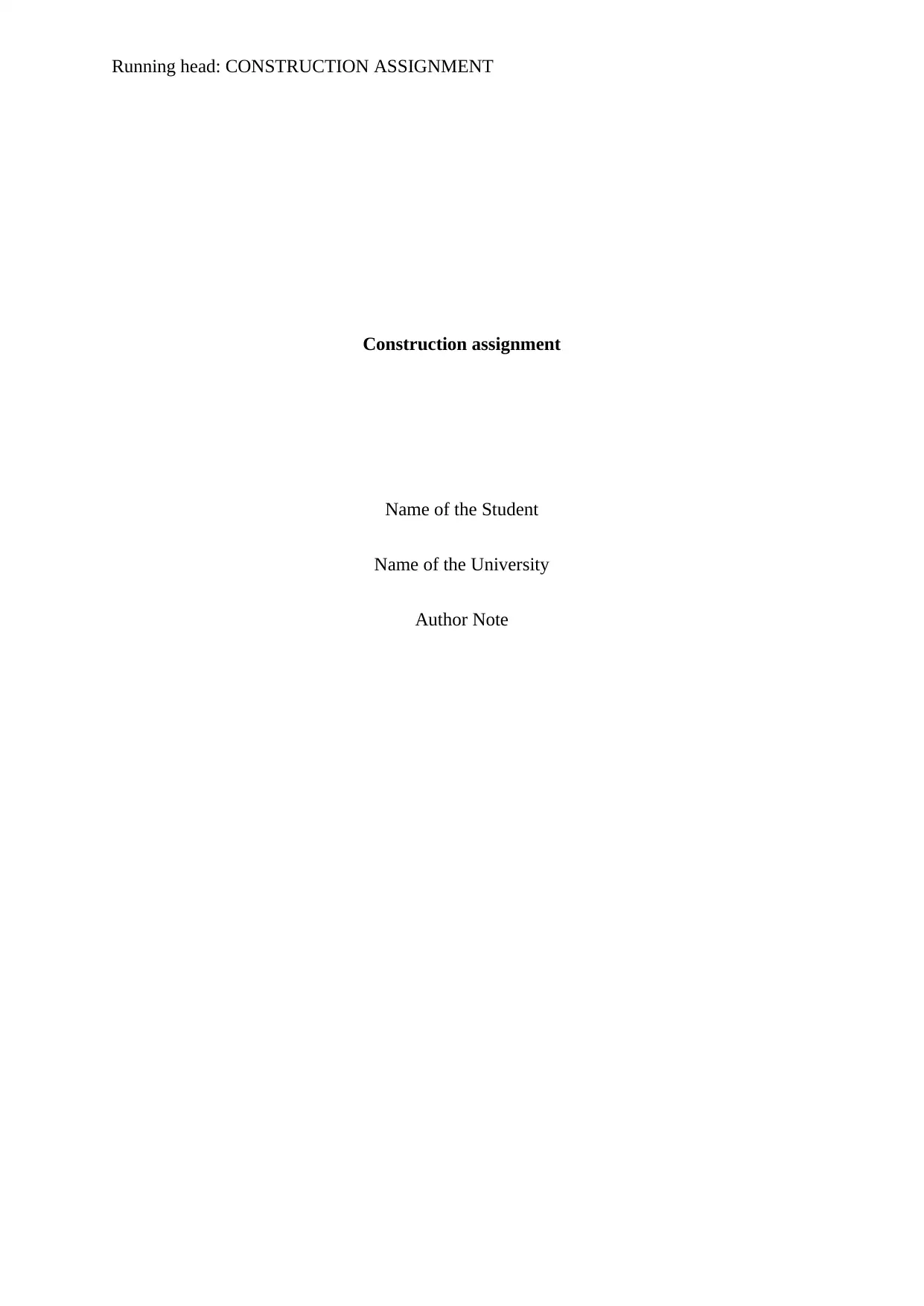
Running head: CONSTRUCTION ASSIGNMENT
Construction assignment
Name of the Student
Name of the University
Author Note
Construction assignment
Name of the Student
Name of the University
Author Note
Paraphrase This Document
Need a fresh take? Get an instant paraphrase of this document with our AI Paraphraser
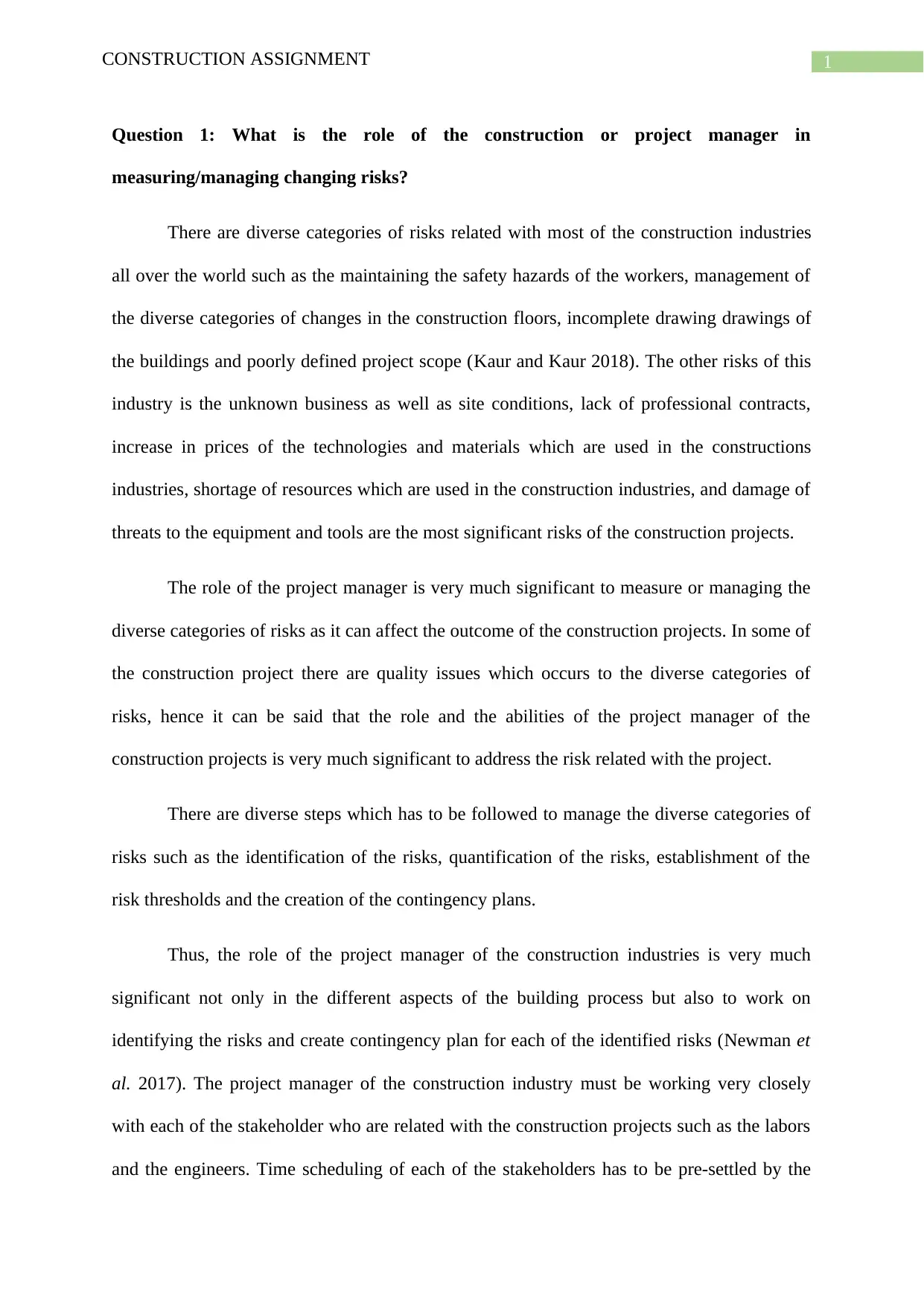
1CONSTRUCTION ASSIGNMENT
Question 1: What is the role of the construction or project manager in
measuring/managing changing risks?
There are diverse categories of risks related with most of the construction industries
all over the world such as the maintaining the safety hazards of the workers, management of
the diverse categories of changes in the construction floors, incomplete drawing drawings of
the buildings and poorly defined project scope (Kaur and Kaur 2018). The other risks of this
industry is the unknown business as well as site conditions, lack of professional contracts,
increase in prices of the technologies and materials which are used in the constructions
industries, shortage of resources which are used in the construction industries, and damage of
threats to the equipment and tools are the most significant risks of the construction projects.
The role of the project manager is very much significant to measure or managing the
diverse categories of risks as it can affect the outcome of the construction projects. In some of
the construction project there are quality issues which occurs to the diverse categories of
risks, hence it can be said that the role and the abilities of the project manager of the
construction projects is very much significant to address the risk related with the project.
There are diverse steps which has to be followed to manage the diverse categories of
risks such as the identification of the risks, quantification of the risks, establishment of the
risk thresholds and the creation of the contingency plans.
Thus, the role of the project manager of the construction industries is very much
significant not only in the different aspects of the building process but also to work on
identifying the risks and create contingency plan for each of the identified risks (Newman et
al. 2017). The project manager of the construction industry must be working very closely
with each of the stakeholder who are related with the construction projects such as the labors
and the engineers. Time scheduling of each of the stakeholders has to be pre-settled by the
Question 1: What is the role of the construction or project manager in
measuring/managing changing risks?
There are diverse categories of risks related with most of the construction industries
all over the world such as the maintaining the safety hazards of the workers, management of
the diverse categories of changes in the construction floors, incomplete drawing drawings of
the buildings and poorly defined project scope (Kaur and Kaur 2018). The other risks of this
industry is the unknown business as well as site conditions, lack of professional contracts,
increase in prices of the technologies and materials which are used in the constructions
industries, shortage of resources which are used in the construction industries, and damage of
threats to the equipment and tools are the most significant risks of the construction projects.
The role of the project manager is very much significant to measure or managing the
diverse categories of risks as it can affect the outcome of the construction projects. In some of
the construction project there are quality issues which occurs to the diverse categories of
risks, hence it can be said that the role and the abilities of the project manager of the
construction projects is very much significant to address the risk related with the project.
There are diverse steps which has to be followed to manage the diverse categories of
risks such as the identification of the risks, quantification of the risks, establishment of the
risk thresholds and the creation of the contingency plans.
Thus, the role of the project manager of the construction industries is very much
significant not only in the different aspects of the building process but also to work on
identifying the risks and create contingency plan for each of the identified risks (Newman et
al. 2017). The project manager of the construction industry must be working very closely
with each of the stakeholder who are related with the construction projects such as the labors
and the engineers. Time scheduling of each of the stakeholders has to be pre-settled by the
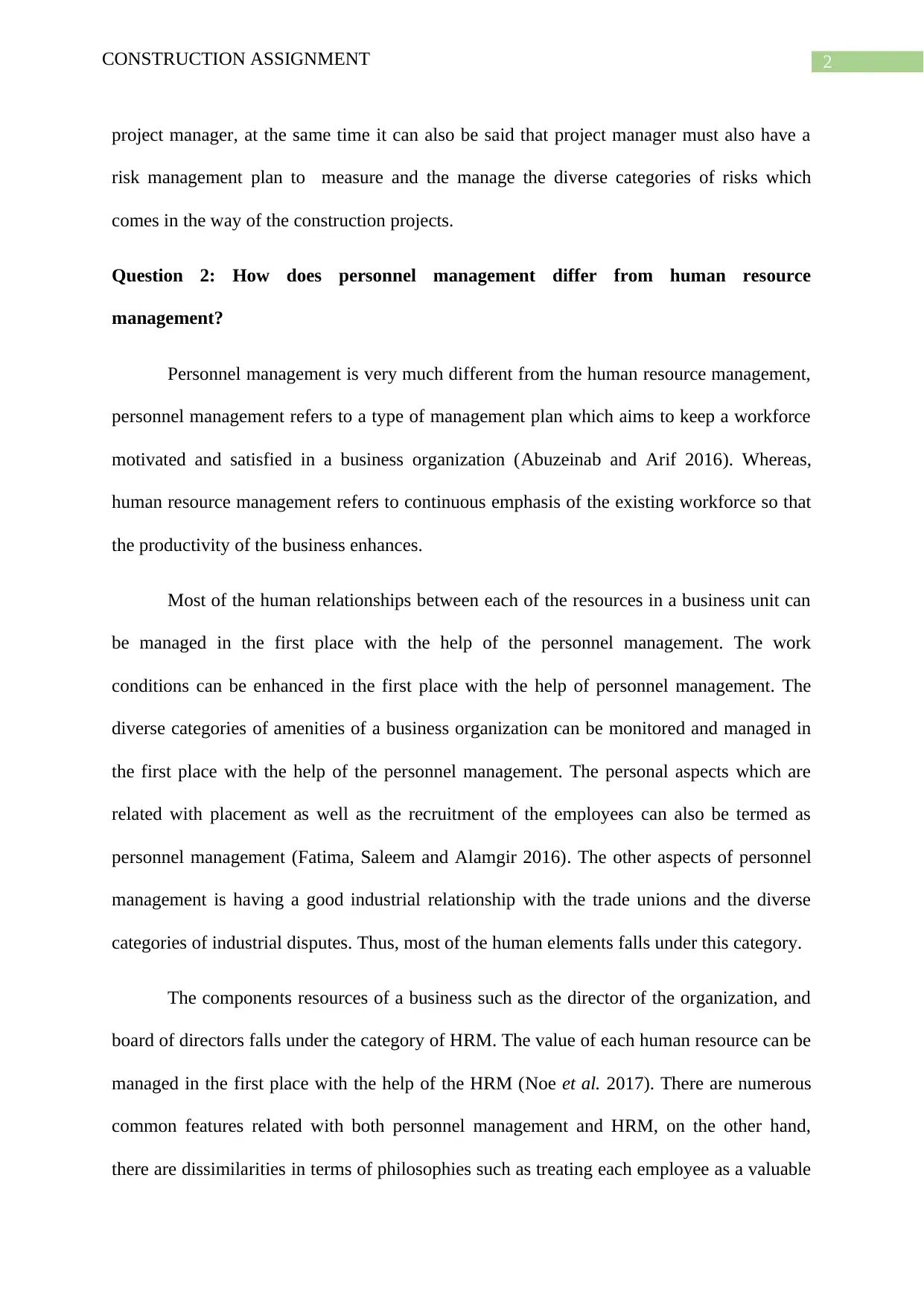
2CONSTRUCTION ASSIGNMENT
project manager, at the same time it can also be said that project manager must also have a
risk management plan to measure and the manage the diverse categories of risks which
comes in the way of the construction projects.
Question 2: How does personnel management differ from human resource
management?
Personnel management is very much different from the human resource management,
personnel management refers to a type of management plan which aims to keep a workforce
motivated and satisfied in a business organization (Abuzeinab and Arif 2016). Whereas,
human resource management refers to continuous emphasis of the existing workforce so that
the productivity of the business enhances.
Most of the human relationships between each of the resources in a business unit can
be managed in the first place with the help of the personnel management. The work
conditions can be enhanced in the first place with the help of personnel management. The
diverse categories of amenities of a business organization can be monitored and managed in
the first place with the help of the personnel management. The personal aspects which are
related with placement as well as the recruitment of the employees can also be termed as
personnel management (Fatima, Saleem and Alamgir 2016). The other aspects of personnel
management is having a good industrial relationship with the trade unions and the diverse
categories of industrial disputes. Thus, most of the human elements falls under this category.
The components resources of a business such as the director of the organization, and
board of directors falls under the category of HRM. The value of each human resource can be
managed in the first place with the help of the HRM (Noe et al. 2017). There are numerous
common features related with both personnel management and HRM, on the other hand,
there are dissimilarities in terms of philosophies such as treating each employee as a valuable
project manager, at the same time it can also be said that project manager must also have a
risk management plan to measure and the manage the diverse categories of risks which
comes in the way of the construction projects.
Question 2: How does personnel management differ from human resource
management?
Personnel management is very much different from the human resource management,
personnel management refers to a type of management plan which aims to keep a workforce
motivated and satisfied in a business organization (Abuzeinab and Arif 2016). Whereas,
human resource management refers to continuous emphasis of the existing workforce so that
the productivity of the business enhances.
Most of the human relationships between each of the resources in a business unit can
be managed in the first place with the help of the personnel management. The work
conditions can be enhanced in the first place with the help of personnel management. The
diverse categories of amenities of a business organization can be monitored and managed in
the first place with the help of the personnel management. The personal aspects which are
related with placement as well as the recruitment of the employees can also be termed as
personnel management (Fatima, Saleem and Alamgir 2016). The other aspects of personnel
management is having a good industrial relationship with the trade unions and the diverse
categories of industrial disputes. Thus, most of the human elements falls under this category.
The components resources of a business such as the director of the organization, and
board of directors falls under the category of HRM. The value of each human resource can be
managed in the first place with the help of the HRM (Noe et al. 2017). There are numerous
common features related with both personnel management and HRM, on the other hand,
there are dissimilarities in terms of philosophies such as treating each employee as a valuable
⊘ This is a preview!⊘
Do you want full access?
Subscribe today to unlock all pages.

Trusted by 1+ million students worldwide
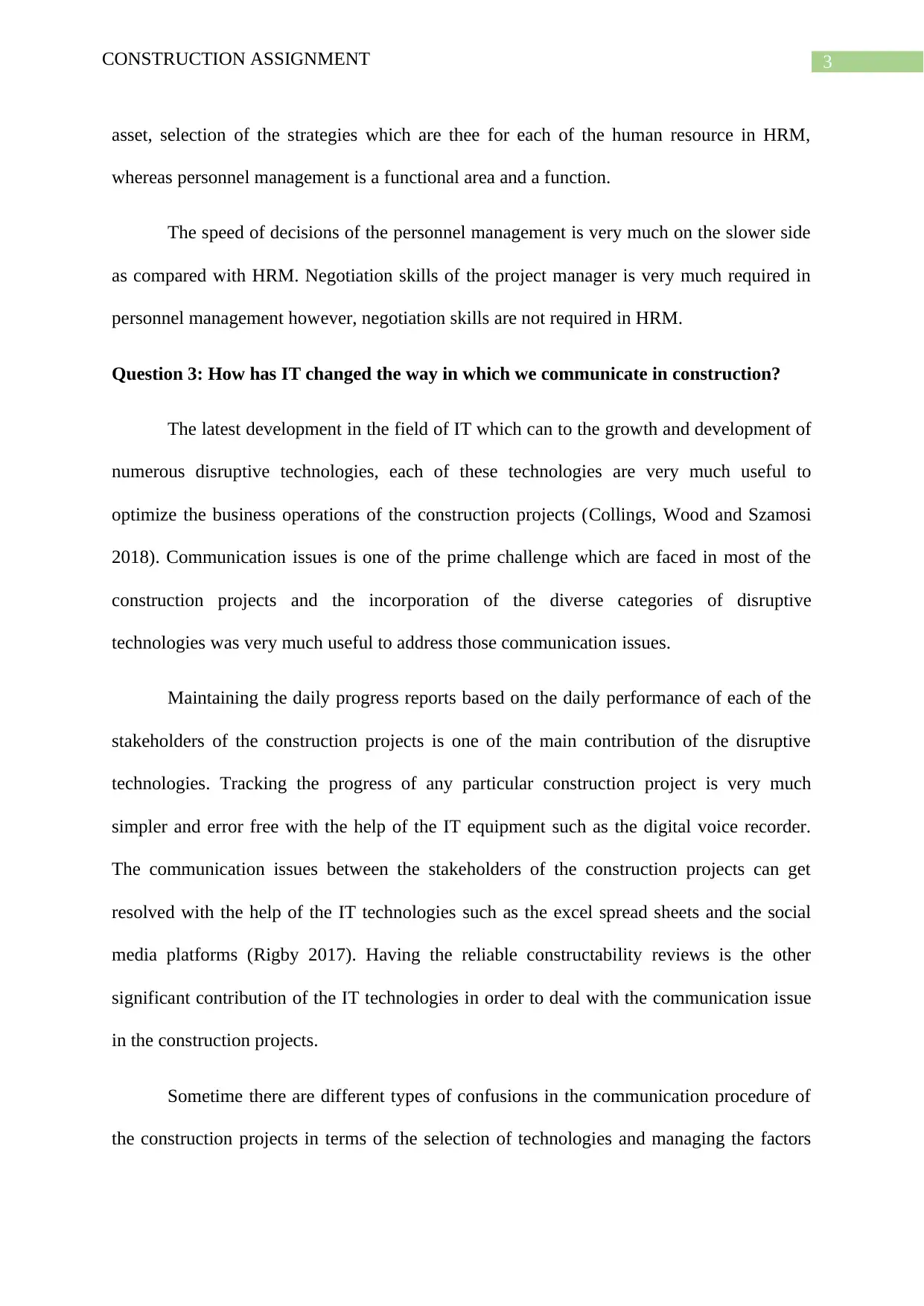
3CONSTRUCTION ASSIGNMENT
asset, selection of the strategies which are thee for each of the human resource in HRM,
whereas personnel management is a functional area and a function.
The speed of decisions of the personnel management is very much on the slower side
as compared with HRM. Negotiation skills of the project manager is very much required in
personnel management however, negotiation skills are not required in HRM.
Question 3: How has IT changed the way in which we communicate in construction?
The latest development in the field of IT which can to the growth and development of
numerous disruptive technologies, each of these technologies are very much useful to
optimize the business operations of the construction projects (Collings, Wood and Szamosi
2018). Communication issues is one of the prime challenge which are faced in most of the
construction projects and the incorporation of the diverse categories of disruptive
technologies was very much useful to address those communication issues.
Maintaining the daily progress reports based on the daily performance of each of the
stakeholders of the construction projects is one of the main contribution of the disruptive
technologies. Tracking the progress of any particular construction project is very much
simpler and error free with the help of the IT equipment such as the digital voice recorder.
The communication issues between the stakeholders of the construction projects can get
resolved with the help of the IT technologies such as the excel spread sheets and the social
media platforms (Rigby 2017). Having the reliable constructability reviews is the other
significant contribution of the IT technologies in order to deal with the communication issue
in the construction projects.
Sometime there are different types of confusions in the communication procedure of
the construction projects in terms of the selection of technologies and managing the factors
asset, selection of the strategies which are thee for each of the human resource in HRM,
whereas personnel management is a functional area and a function.
The speed of decisions of the personnel management is very much on the slower side
as compared with HRM. Negotiation skills of the project manager is very much required in
personnel management however, negotiation skills are not required in HRM.
Question 3: How has IT changed the way in which we communicate in construction?
The latest development in the field of IT which can to the growth and development of
numerous disruptive technologies, each of these technologies are very much useful to
optimize the business operations of the construction projects (Collings, Wood and Szamosi
2018). Communication issues is one of the prime challenge which are faced in most of the
construction projects and the incorporation of the diverse categories of disruptive
technologies was very much useful to address those communication issues.
Maintaining the daily progress reports based on the daily performance of each of the
stakeholders of the construction projects is one of the main contribution of the disruptive
technologies. Tracking the progress of any particular construction project is very much
simpler and error free with the help of the IT equipment such as the digital voice recorder.
The communication issues between the stakeholders of the construction projects can get
resolved with the help of the IT technologies such as the excel spread sheets and the social
media platforms (Rigby 2017). Having the reliable constructability reviews is the other
significant contribution of the IT technologies in order to deal with the communication issue
in the construction projects.
Sometime there are different types of confusions in the communication procedure of
the construction projects in terms of the selection of technologies and managing the factors
Paraphrase This Document
Need a fresh take? Get an instant paraphrase of this document with our AI Paraphraser
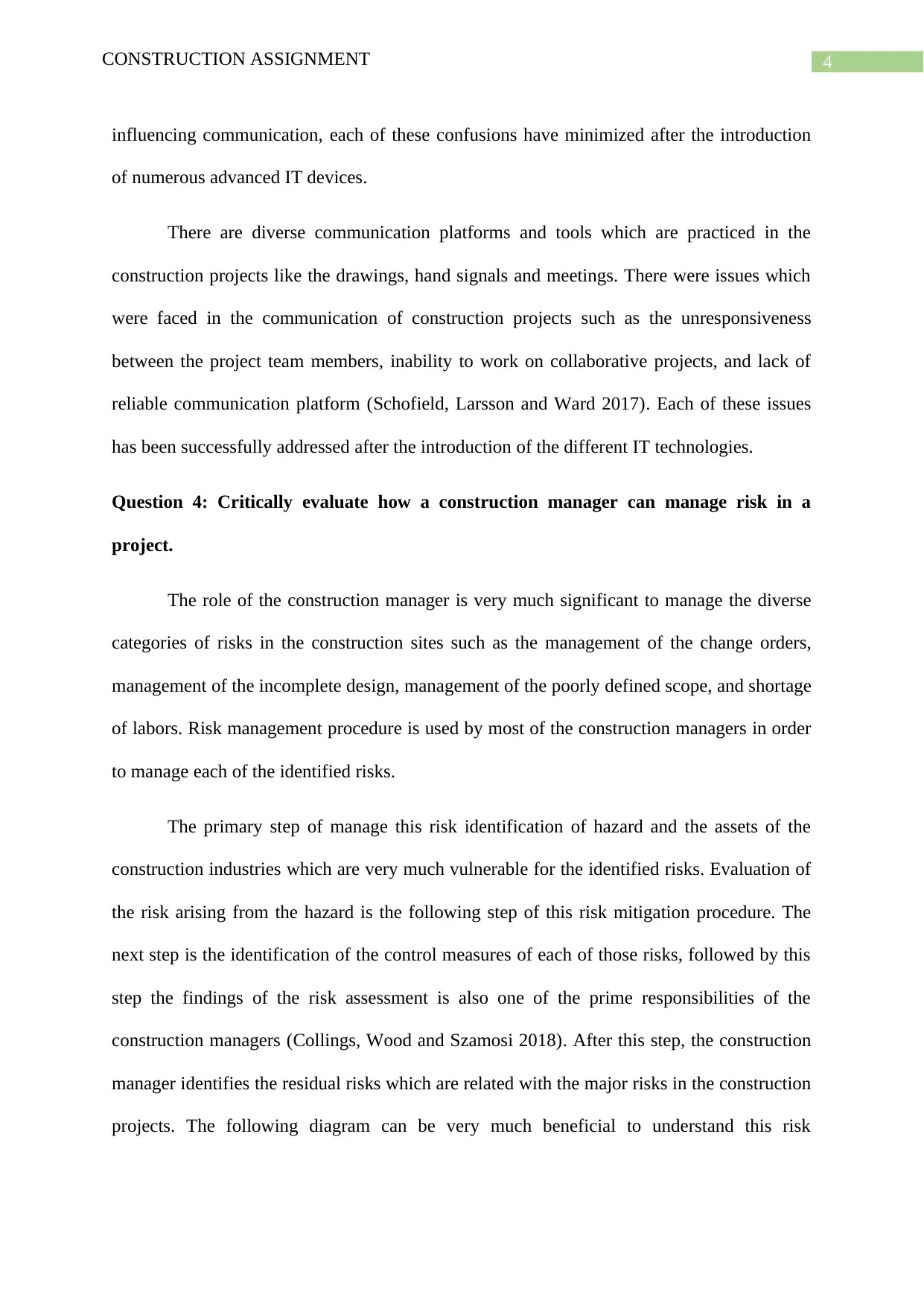
4CONSTRUCTION ASSIGNMENT
influencing communication, each of these confusions have minimized after the introduction
of numerous advanced IT devices.
There are diverse communication platforms and tools which are practiced in the
construction projects like the drawings, hand signals and meetings. There were issues which
were faced in the communication of construction projects such as the unresponsiveness
between the project team members, inability to work on collaborative projects, and lack of
reliable communication platform (Schofield, Larsson and Ward 2017). Each of these issues
has been successfully addressed after the introduction of the different IT technologies.
Question 4: Critically evaluate how a construction manager can manage risk in a
project.
The role of the construction manager is very much significant to manage the diverse
categories of risks in the construction sites such as the management of the change orders,
management of the incomplete design, management of the poorly defined scope, and shortage
of labors. Risk management procedure is used by most of the construction managers in order
to manage each of the identified risks.
The primary step of manage this risk identification of hazard and the assets of the
construction industries which are very much vulnerable for the identified risks. Evaluation of
the risk arising from the hazard is the following step of this risk mitigation procedure. The
next step is the identification of the control measures of each of those risks, followed by this
step the findings of the risk assessment is also one of the prime responsibilities of the
construction managers (Collings, Wood and Szamosi 2018). After this step, the construction
manager identifies the residual risks which are related with the major risks in the construction
projects. The following diagram can be very much beneficial to understand this risk
influencing communication, each of these confusions have minimized after the introduction
of numerous advanced IT devices.
There are diverse communication platforms and tools which are practiced in the
construction projects like the drawings, hand signals and meetings. There were issues which
were faced in the communication of construction projects such as the unresponsiveness
between the project team members, inability to work on collaborative projects, and lack of
reliable communication platform (Schofield, Larsson and Ward 2017). Each of these issues
has been successfully addressed after the introduction of the different IT technologies.
Question 4: Critically evaluate how a construction manager can manage risk in a
project.
The role of the construction manager is very much significant to manage the diverse
categories of risks in the construction sites such as the management of the change orders,
management of the incomplete design, management of the poorly defined scope, and shortage
of labors. Risk management procedure is used by most of the construction managers in order
to manage each of the identified risks.
The primary step of manage this risk identification of hazard and the assets of the
construction industries which are very much vulnerable for the identified risks. Evaluation of
the risk arising from the hazard is the following step of this risk mitigation procedure. The
next step is the identification of the control measures of each of those risks, followed by this
step the findings of the risk assessment is also one of the prime responsibilities of the
construction managers (Collings, Wood and Szamosi 2018). After this step, the construction
manager identifies the residual risks which are related with the major risks in the construction
projects. The following diagram can be very much beneficial to understand this risk
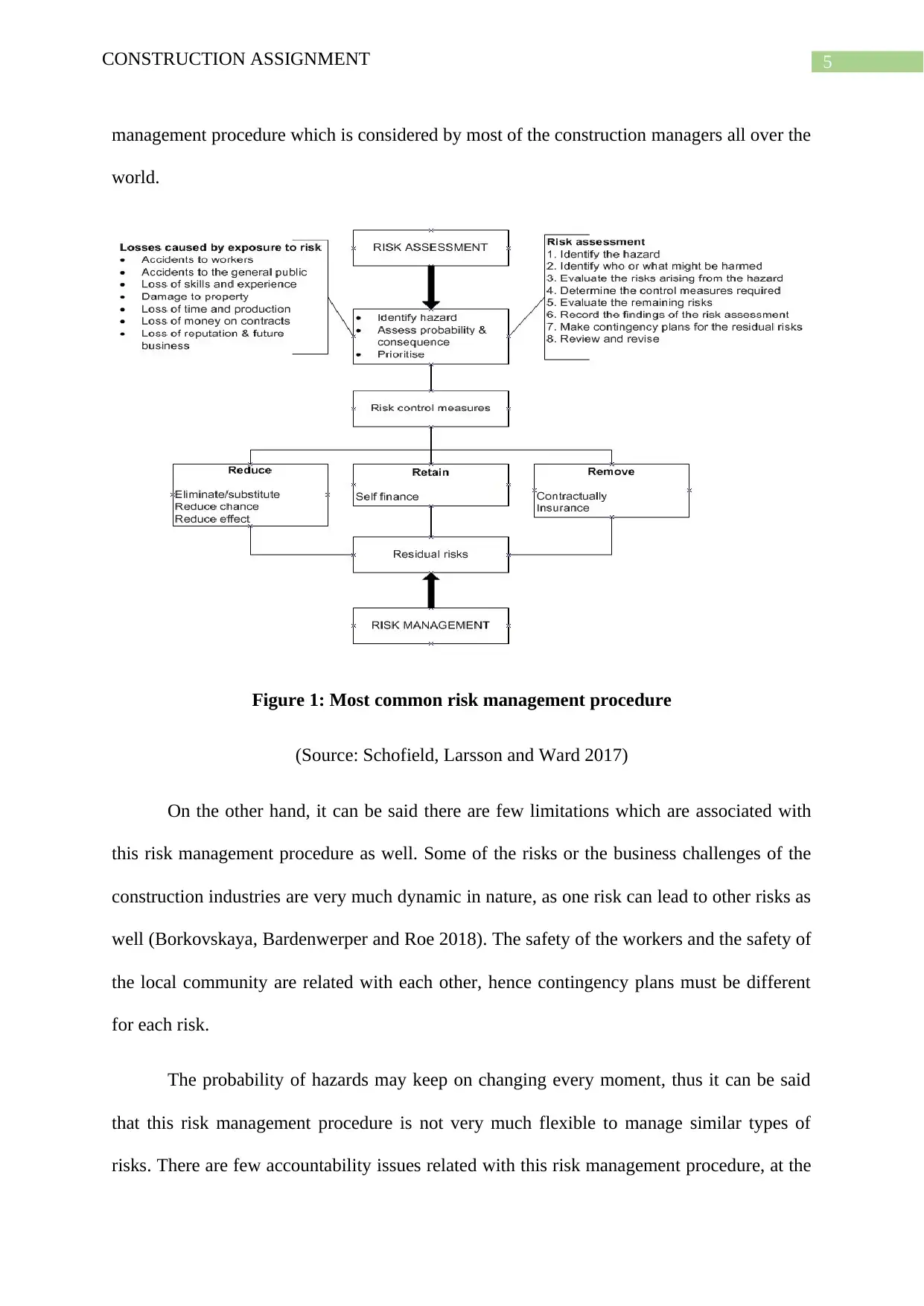
5CONSTRUCTION ASSIGNMENT
management procedure which is considered by most of the construction managers all over the
world.
Figure 1: Most common risk management procedure
(Source: Schofield, Larsson and Ward 2017)
On the other hand, it can be said there are few limitations which are associated with
this risk management procedure as well. Some of the risks or the business challenges of the
construction industries are very much dynamic in nature, as one risk can lead to other risks as
well (Borkovskaya, Bardenwerper and Roe 2018). The safety of the workers and the safety of
the local community are related with each other, hence contingency plans must be different
for each risk.
The probability of hazards may keep on changing every moment, thus it can be said
that this risk management procedure is not very much flexible to manage similar types of
risks. There are few accountability issues related with this risk management procedure, at the
management procedure which is considered by most of the construction managers all over the
world.
Figure 1: Most common risk management procedure
(Source: Schofield, Larsson and Ward 2017)
On the other hand, it can be said there are few limitations which are associated with
this risk management procedure as well. Some of the risks or the business challenges of the
construction industries are very much dynamic in nature, as one risk can lead to other risks as
well (Borkovskaya, Bardenwerper and Roe 2018). The safety of the workers and the safety of
the local community are related with each other, hence contingency plans must be different
for each risk.
The probability of hazards may keep on changing every moment, thus it can be said
that this risk management procedure is not very much flexible to manage similar types of
risks. There are few accountability issues related with this risk management procedure, at the
⊘ This is a preview!⊘
Do you want full access?
Subscribe today to unlock all pages.

Trusted by 1+ million students worldwide
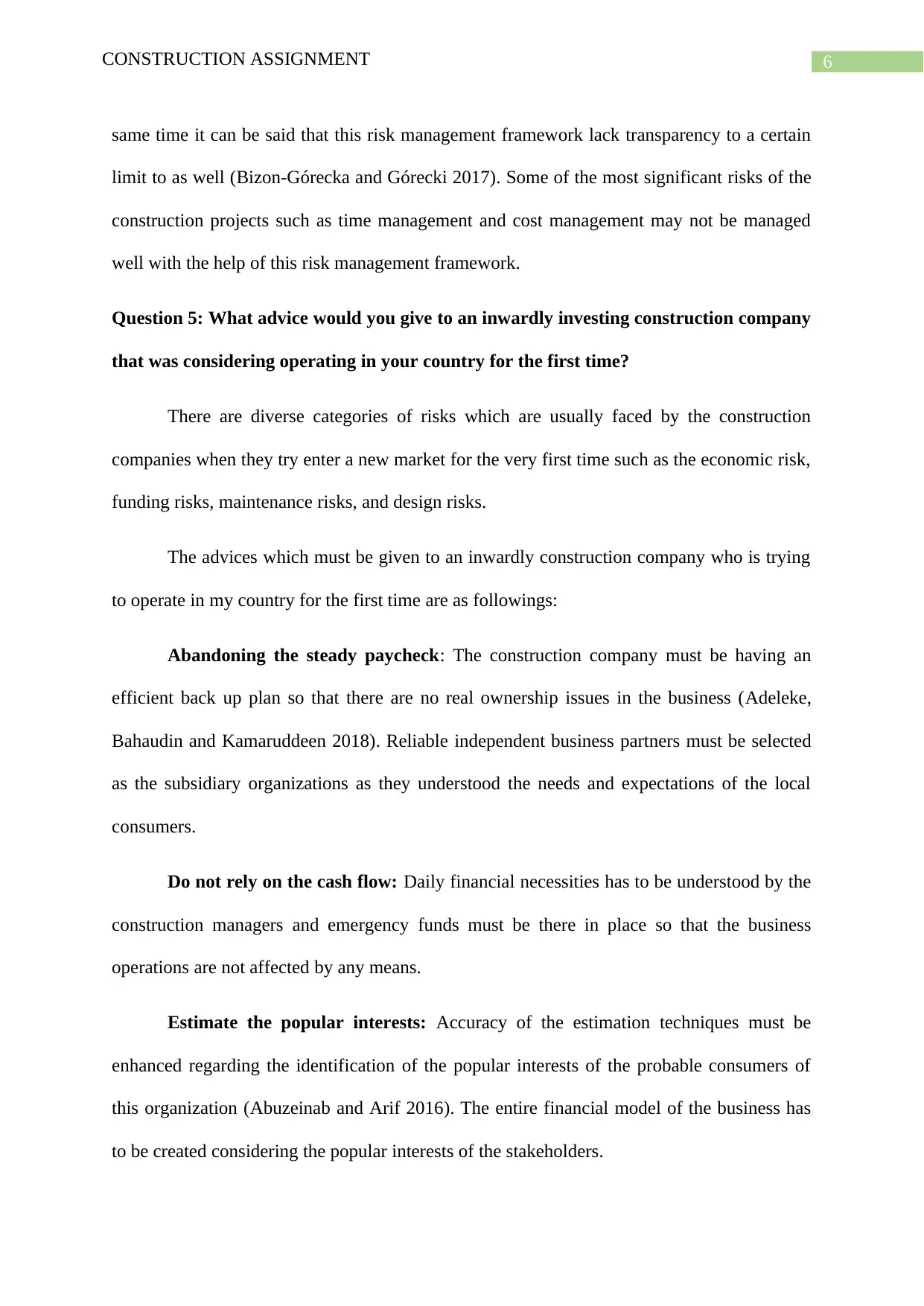
6CONSTRUCTION ASSIGNMENT
same time it can be said that this risk management framework lack transparency to a certain
limit to as well (Bizon-Górecka and Górecki 2017). Some of the most significant risks of the
construction projects such as time management and cost management may not be managed
well with the help of this risk management framework.
Question 5: What advice would you give to an inwardly investing construction company
that was considering operating in your country for the first time?
There are diverse categories of risks which are usually faced by the construction
companies when they try enter a new market for the very first time such as the economic risk,
funding risks, maintenance risks, and design risks.
The advices which must be given to an inwardly construction company who is trying
to operate in my country for the first time are as followings:
Abandoning the steady paycheck: The construction company must be having an
efficient back up plan so that there are no real ownership issues in the business (Adeleke,
Bahaudin and Kamaruddeen 2018). Reliable independent business partners must be selected
as the subsidiary organizations as they understood the needs and expectations of the local
consumers.
Do not rely on the cash flow: Daily financial necessities has to be understood by the
construction managers and emergency funds must be there in place so that the business
operations are not affected by any means.
Estimate the popular interests: Accuracy of the estimation techniques must be
enhanced regarding the identification of the popular interests of the probable consumers of
this organization (Abuzeinab and Arif 2016). The entire financial model of the business has
to be created considering the popular interests of the stakeholders.
same time it can be said that this risk management framework lack transparency to a certain
limit to as well (Bizon-Górecka and Górecki 2017). Some of the most significant risks of the
construction projects such as time management and cost management may not be managed
well with the help of this risk management framework.
Question 5: What advice would you give to an inwardly investing construction company
that was considering operating in your country for the first time?
There are diverse categories of risks which are usually faced by the construction
companies when they try enter a new market for the very first time such as the economic risk,
funding risks, maintenance risks, and design risks.
The advices which must be given to an inwardly construction company who is trying
to operate in my country for the first time are as followings:
Abandoning the steady paycheck: The construction company must be having an
efficient back up plan so that there are no real ownership issues in the business (Adeleke,
Bahaudin and Kamaruddeen 2018). Reliable independent business partners must be selected
as the subsidiary organizations as they understood the needs and expectations of the local
consumers.
Do not rely on the cash flow: Daily financial necessities has to be understood by the
construction managers and emergency funds must be there in place so that the business
operations are not affected by any means.
Estimate the popular interests: Accuracy of the estimation techniques must be
enhanced regarding the identification of the popular interests of the probable consumers of
this organization (Abuzeinab and Arif 2016). The entire financial model of the business has
to be created considering the popular interests of the stakeholders.
Paraphrase This Document
Need a fresh take? Get an instant paraphrase of this document with our AI Paraphraser
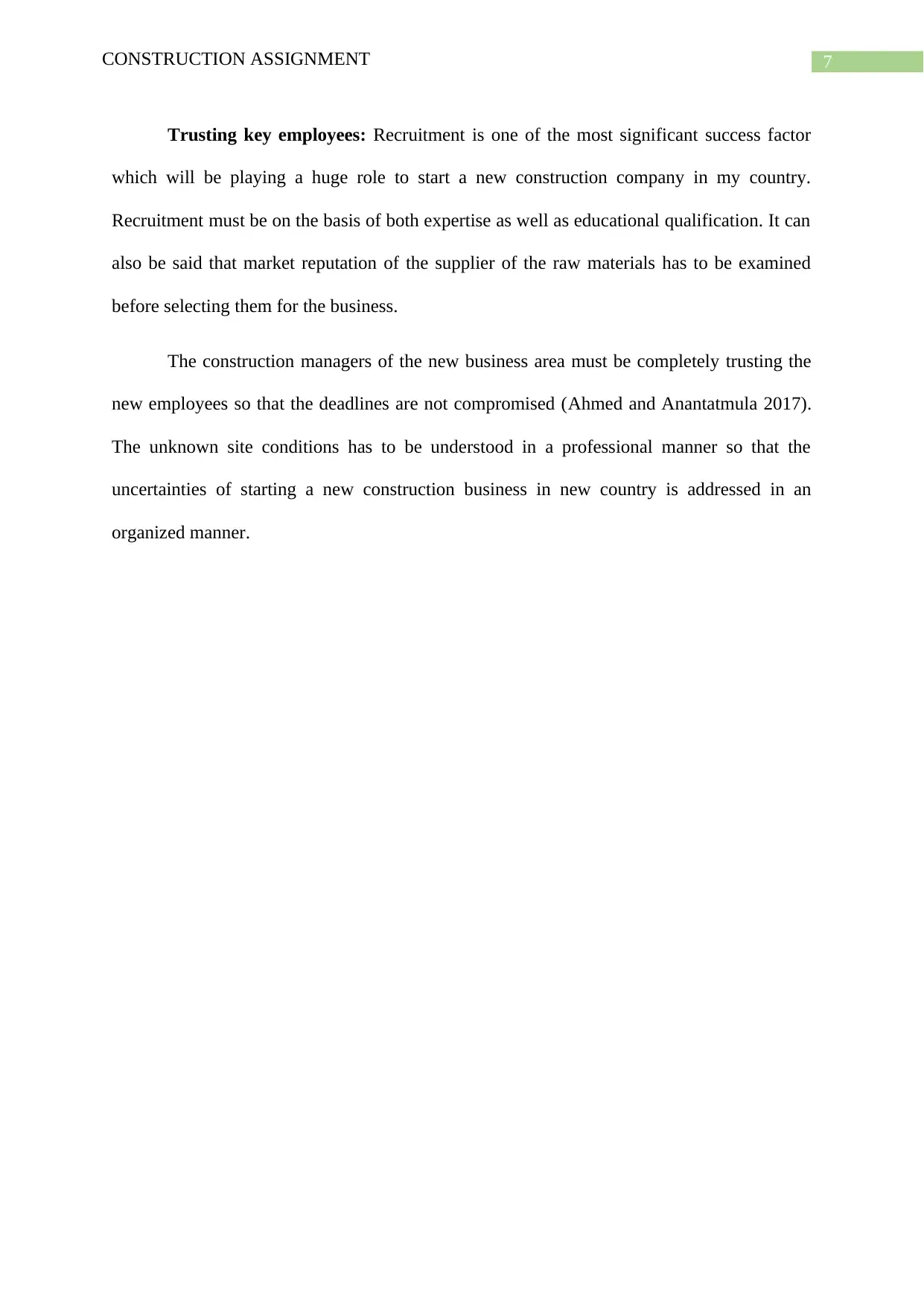
7CONSTRUCTION ASSIGNMENT
Trusting key employees: Recruitment is one of the most significant success factor
which will be playing a huge role to start a new construction company in my country.
Recruitment must be on the basis of both expertise as well as educational qualification. It can
also be said that market reputation of the supplier of the raw materials has to be examined
before selecting them for the business.
The construction managers of the new business area must be completely trusting the
new employees so that the deadlines are not compromised (Ahmed and Anantatmula 2017).
The unknown site conditions has to be understood in a professional manner so that the
uncertainties of starting a new construction business in new country is addressed in an
organized manner.
Trusting key employees: Recruitment is one of the most significant success factor
which will be playing a huge role to start a new construction company in my country.
Recruitment must be on the basis of both expertise as well as educational qualification. It can
also be said that market reputation of the supplier of the raw materials has to be examined
before selecting them for the business.
The construction managers of the new business area must be completely trusting the
new employees so that the deadlines are not compromised (Ahmed and Anantatmula 2017).
The unknown site conditions has to be understood in a professional manner so that the
uncertainties of starting a new construction business in new country is addressed in an
organized manner.
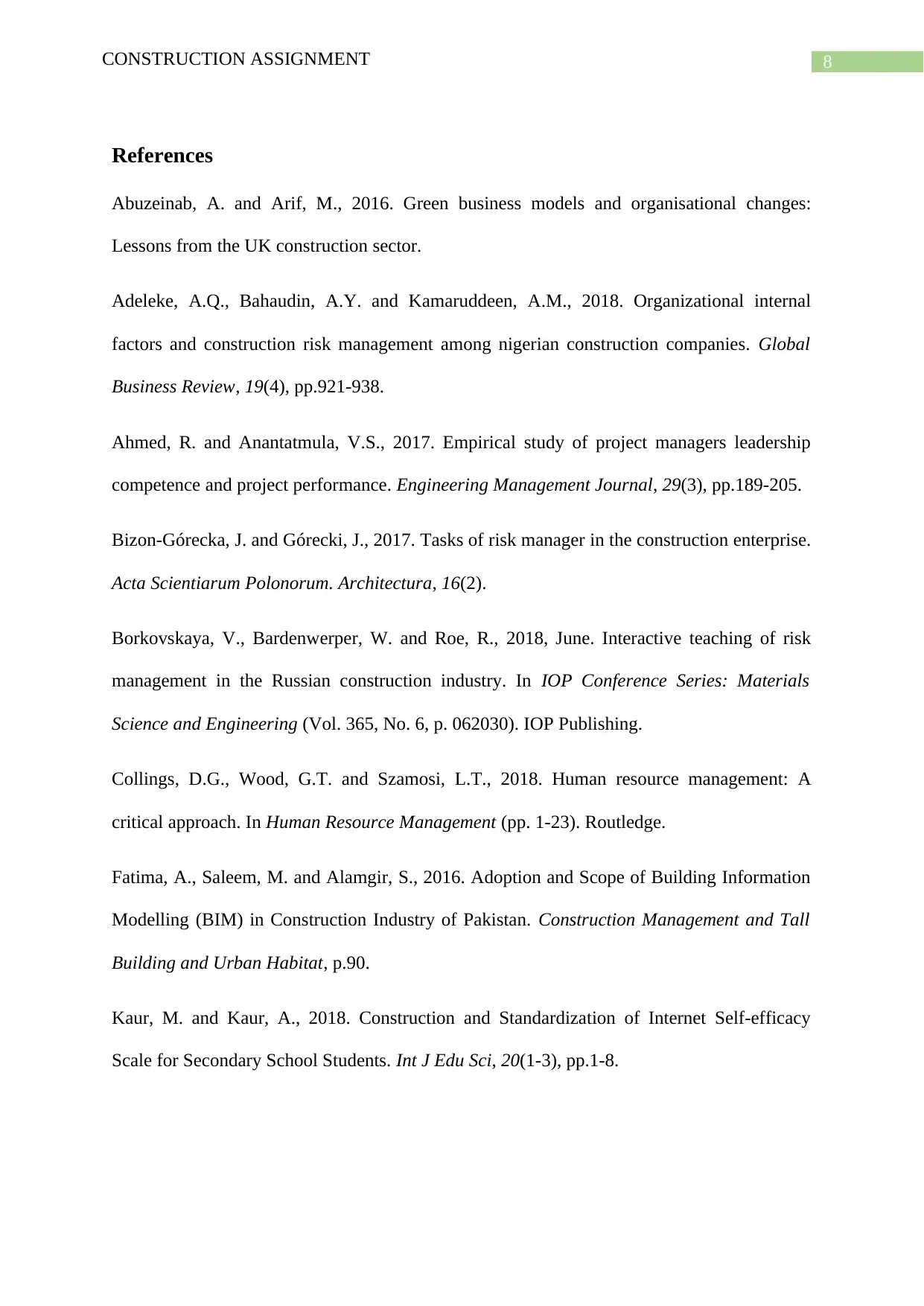
8CONSTRUCTION ASSIGNMENT
References
Abuzeinab, A. and Arif, M., 2016. Green business models and organisational changes:
Lessons from the UK construction sector.
Adeleke, A.Q., Bahaudin, A.Y. and Kamaruddeen, A.M., 2018. Organizational internal
factors and construction risk management among nigerian construction companies. Global
Business Review, 19(4), pp.921-938.
Ahmed, R. and Anantatmula, V.S., 2017. Empirical study of project managers leadership
competence and project performance. Engineering Management Journal, 29(3), pp.189-205.
Bizon-Górecka, J. and Górecki, J., 2017. Tasks of risk manager in the construction enterprise.
Acta Scientiarum Polonorum. Architectura, 16(2).
Borkovskaya, V., Bardenwerper, W. and Roe, R., 2018, June. Interactive teaching of risk
management in the Russian construction industry. In IOP Conference Series: Materials
Science and Engineering (Vol. 365, No. 6, p. 062030). IOP Publishing.
Collings, D.G., Wood, G.T. and Szamosi, L.T., 2018. Human resource management: A
critical approach. In Human Resource Management (pp. 1-23). Routledge.
Fatima, A., Saleem, M. and Alamgir, S., 2016. Adoption and Scope of Building Information
Modelling (BIM) in Construction Industry of Pakistan. Construction Management and Tall
Building and Urban Habitat, p.90.
Kaur, M. and Kaur, A., 2018. Construction and Standardization of Internet Self-efficacy
Scale for Secondary School Students. Int J Edu Sci, 20(1-3), pp.1-8.
References
Abuzeinab, A. and Arif, M., 2016. Green business models and organisational changes:
Lessons from the UK construction sector.
Adeleke, A.Q., Bahaudin, A.Y. and Kamaruddeen, A.M., 2018. Organizational internal
factors and construction risk management among nigerian construction companies. Global
Business Review, 19(4), pp.921-938.
Ahmed, R. and Anantatmula, V.S., 2017. Empirical study of project managers leadership
competence and project performance. Engineering Management Journal, 29(3), pp.189-205.
Bizon-Górecka, J. and Górecki, J., 2017. Tasks of risk manager in the construction enterprise.
Acta Scientiarum Polonorum. Architectura, 16(2).
Borkovskaya, V., Bardenwerper, W. and Roe, R., 2018, June. Interactive teaching of risk
management in the Russian construction industry. In IOP Conference Series: Materials
Science and Engineering (Vol. 365, No. 6, p. 062030). IOP Publishing.
Collings, D.G., Wood, G.T. and Szamosi, L.T., 2018. Human resource management: A
critical approach. In Human Resource Management (pp. 1-23). Routledge.
Fatima, A., Saleem, M. and Alamgir, S., 2016. Adoption and Scope of Building Information
Modelling (BIM) in Construction Industry of Pakistan. Construction Management and Tall
Building and Urban Habitat, p.90.
Kaur, M. and Kaur, A., 2018. Construction and Standardization of Internet Self-efficacy
Scale for Secondary School Students. Int J Edu Sci, 20(1-3), pp.1-8.
⊘ This is a preview!⊘
Do you want full access?
Subscribe today to unlock all pages.

Trusted by 1+ million students worldwide
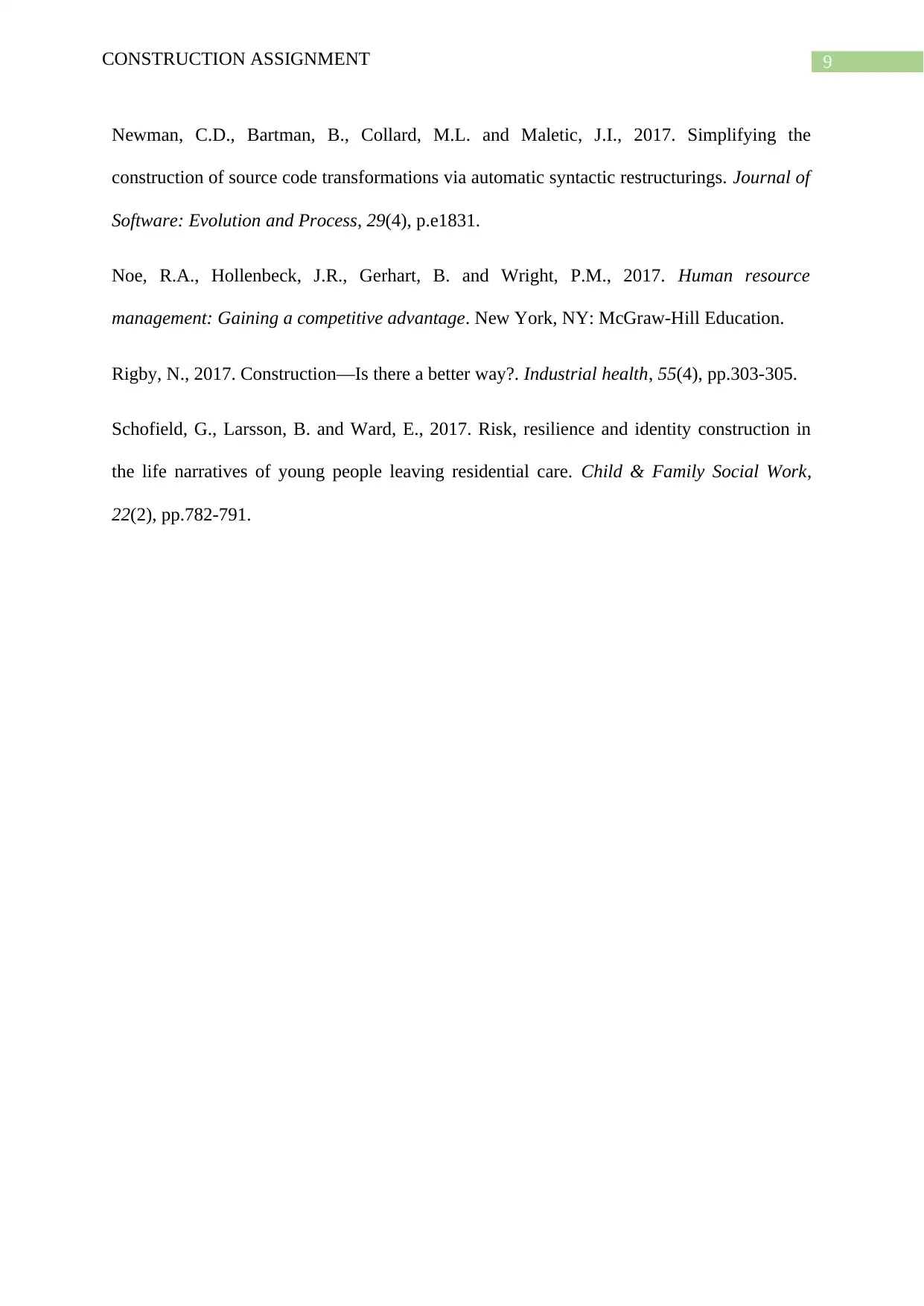
9CONSTRUCTION ASSIGNMENT
Newman, C.D., Bartman, B., Collard, M.L. and Maletic, J.I., 2017. Simplifying the
construction of source code transformations via automatic syntactic restructurings. Journal of
Software: Evolution and Process, 29(4), p.e1831.
Noe, R.A., Hollenbeck, J.R., Gerhart, B. and Wright, P.M., 2017. Human resource
management: Gaining a competitive advantage. New York, NY: McGraw-Hill Education.
Rigby, N., 2017. Construction—Is there a better way?. Industrial health, 55(4), pp.303-305.
Schofield, G., Larsson, B. and Ward, E., 2017. Risk, resilience and identity construction in
the life narratives of young people leaving residential care. Child & Family Social Work,
22(2), pp.782-791.
Newman, C.D., Bartman, B., Collard, M.L. and Maletic, J.I., 2017. Simplifying the
construction of source code transformations via automatic syntactic restructurings. Journal of
Software: Evolution and Process, 29(4), p.e1831.
Noe, R.A., Hollenbeck, J.R., Gerhart, B. and Wright, P.M., 2017. Human resource
management: Gaining a competitive advantage. New York, NY: McGraw-Hill Education.
Rigby, N., 2017. Construction—Is there a better way?. Industrial health, 55(4), pp.303-305.
Schofield, G., Larsson, B. and Ward, E., 2017. Risk, resilience and identity construction in
the life narratives of young people leaving residential care. Child & Family Social Work,
22(2), pp.782-791.
1 out of 10
Related Documents
Your All-in-One AI-Powered Toolkit for Academic Success.
+13062052269
info@desklib.com
Available 24*7 on WhatsApp / Email
![[object Object]](/_next/static/media/star-bottom.7253800d.svg)
Unlock your academic potential
Copyright © 2020–2025 A2Z Services. All Rights Reserved. Developed and managed by ZUCOL.





